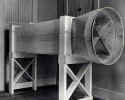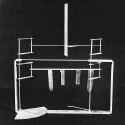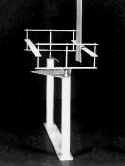|
 ne of
the most important machines the Wright brothers built wasn't an airplane, but a
tunnel. Discouraged by the performance of their first two gliders, they
suspected that the lift and drag data they had used to design them was
incorrect. They resolved to compile their own information, and true to form,
designed their own instruments to do it. The 1901 Wright wind tunnel, the lift
balance, and the drift (drag) balance were deceptively simple. The tunnel was
little more than a pine box; the balances were made from spoke wire and
discarded hacksaw blades. But they were ingeniously fashioned and remarkably
sensitive. Using these homemade scientific instruments, the Wrights were the
first to measure the forces on a wing in fight and use them to determine the
design of an airplane. Their very next aircraft --
the 1902 Wright glider -- was a breakthrough in aeronautical design. It
eventually became the granddaddy of every successful airplane built in its wake.
If you'd like to read the story of the wind tunnel in its entirety -- how the
Wright brothers designed their wind tunnel balances and how they collected their
data -- see Lift and Drift. ne of
the most important machines the Wright brothers built wasn't an airplane, but a
tunnel. Discouraged by the performance of their first two gliders, they
suspected that the lift and drag data they had used to design them was
incorrect. They resolved to compile their own information, and true to form,
designed their own instruments to do it. The 1901 Wright wind tunnel, the lift
balance, and the drift (drag) balance were deceptively simple. The tunnel was
little more than a pine box; the balances were made from spoke wire and
discarded hacksaw blades. But they were ingeniously fashioned and remarkably
sensitive. Using these homemade scientific instruments, the Wrights were the
first to measure the forces on a wing in fight and use them to determine the
design of an airplane. Their very next aircraft --
the 1902 Wright glider -- was a breakthrough in aeronautical design. It
eventually became the granddaddy of every successful airplane built in its wake.
If you'd like to read the story of the wind tunnel in its entirety -- how the
Wright brothers designed their wind tunnel balances and how they collected their
data -- see Lift and Drift.
If you would like to make a replica of the Wright wind tunnel,
or if you would just like to study its design to glean a better understanding of
the innovative minds of the Wright brothers, we've posted the engineering
drawings here. You may download them free with our good wishes.
However, remember these are copyrighted plans and the
copyright holder (us) claims all privileges and protection afforded by law.
If you use or distribute these plans, you are bound to these conditions:
- You may not sell or profit from these plans.
- You cannot charge copying, handling, postage, or shipping
fees. If we can contribute hundreds of hours of research, you can kick in a
little paper and postage.
- If you find a mistake on these drawings, you are
honor-bound to let us know so we can correct it and make the plans better
for those who come after you.
- If you know of or discover better methods or additional
suppliers of materials for building this wind tunnel and its balances other than those we describe
in the plans or on this web site, you are honor-bound to tell us so we can
distribute the information and continue to make this project a better
experience, especially for the young people who participate.
- You may make single copies for friends and acquaintances,
but you may not publish these plans and offer them to the public in any
form, electronic or paper, without written permission of the copyright
holder.
There are 9 sheets of drawings, shown
in thumbnails below. To save the sheets to your computer, right click on
the thumbnail and choose "Save Target As" (in Explorer) or "Save
Link As" (in Navigator) from the pop-up menu that appears. Save the JPEG
file to a folder on your hard drive. These are big files; some pages are more
than 1 meg. So it may take a while to download the entire set, depending on the
speed of your modem.
By the way -- we offer a four color booklet, printed
11 inches by 17 inches, that contains these drawings, plus the
illustrated instructions and mathematical formulas need to duplicate the
Wright wind tunnel experiments. See our page of WBAC
Plans. |



These replicas of the 1901 Wright wind tunnel (top),
the lift balance (middle) and the drift balance (bottom) are on display at
the United States Air Force Museum
|

